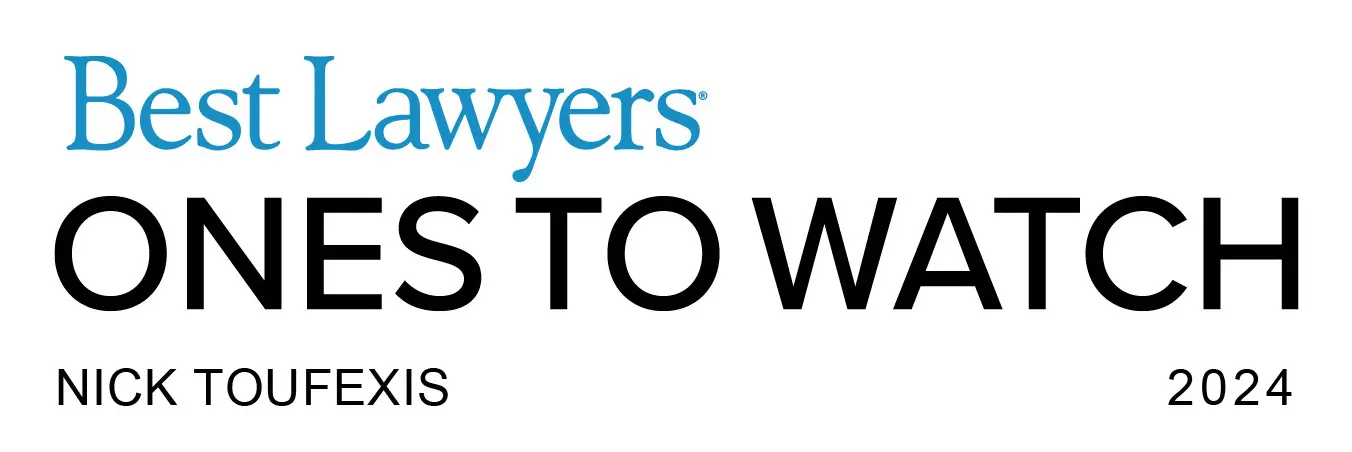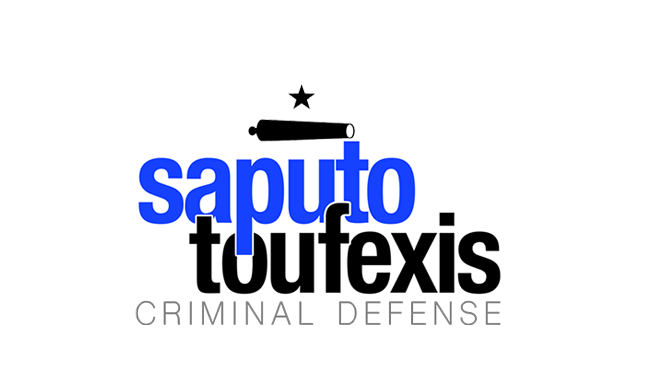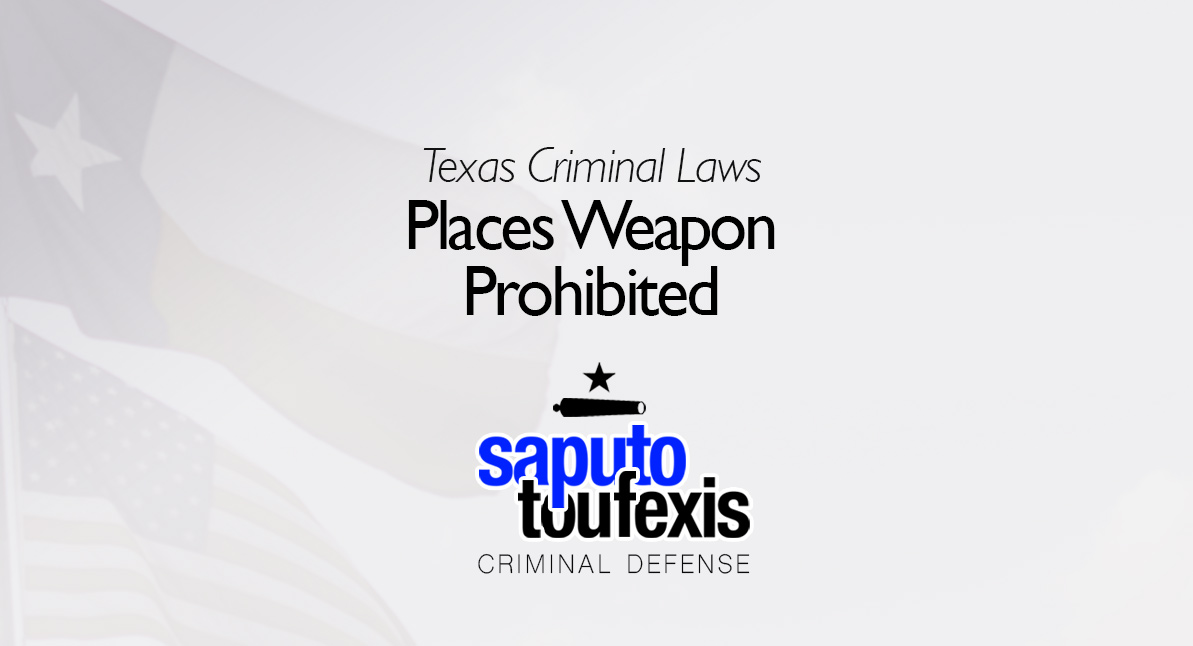The Texas Places Weapons Prohibited law makes it illegal for people to possess a firearm, location-restricted knife, club, and other certain weapons in certain places described by the statute, including racetracks, the secured area of airports, bars, correctional facilities, and others.
FAQs about the
Places Weapons Prohibited law in Texas
- What is the current Texas law about Places Weapons Prohibited?
- What weapons are covered?
- Who is not covered by the Places Weapons Prohibited offense?
- Does Places Weapons Prohibited apply to soldiers, officers of the court or penal institution guards?
- What are the other statutory defenses to the Places Weapons Prohibited offense?
- What if I had a handgun license?
- What is the statute of limitation for Places Weapons Prohibited in Texas?
- What is the penalty for a Texas Places Weapons Prohibited offense?
- Can you get probation for Places Weapons Prohibited in Texas?
- What level of crime is Places Weapons Prohibited in Texas?
To obtain a conviction, the state’s attorneys must prove that you intentionally, knowingly, or recklessly possessed a weapon covered under the statute or went to a prohibited place with one of those weapons.
Have you been charged with Places Weapons Prohibited? Contact us today to discuss legal representation.
or Text or Call (888) 239-9305
The Texas legislature codified this criminal offense in Texas Penal Code Section 46.03. The Places Weapons Prohibited offense has been amended numerous times since 2015, including most recently in 2023. The most significant update was in 2021. This article analyzes all of these amendments below.
Many of the amendments have been the result of, or led to, significant controversy.
The Penal Code classifies the Texas Places Weapons Prohibited law under Title 10 “Offenses Against Public Health, Safety, and Morals,” Chapter 46 “Weapons.” Learn more about the Texas offense of Places Weapons Prohibited below.
What is the current Texas law about Places Weapons Prohibited?
The current Texas law defines the offense of Places Weapon Prohibited in Penal Code Section §46.03 as follows:[1]
(a) A person commits an offense if the person intentionally, knowingly, or recklessly possesses or goes with a firearm, location-restricted knife, club, or prohibited weapon listed in Section 46.05(a):
(1) on the premises of a school or postsecondary educational institution, on any grounds or building owned by and under the control of a school or postsecondary educational institution and on which an activity sponsored by the school or institution is being conducted, or in a passenger transportation vehicle of a school or postsecondary educational institution, whether the school or postsecondary educational institution is public or private, unless:
(A) pursuant to written regulations or written authorization of the school or institution; or
(B) the person possesses or goes with a concealed handgun that the person is licensed to carry under Subchapter H, Chapter 411, Government Code, and no other weapon to which this section applies, on the premises of a postsecondary educational institution, on any grounds or building owned by and under the control of the institution and on which an activity sponsored by the institution is being conducted, or in a passenger transportation vehicle of the institution;
This first subdivision, (a)(1), includes schools, events sponsored by schools and school vehicles, but there are two exceptions. Carrying a weapon is not prohibited on the school premises if the institution authorized the carrying of the weapon in writing or if you are carrying a licensed concealed weapon on a college campus or a place where the college is sponsoring an event:[2] The exception in subdivision (1)(B) that allows for carrying concealed handguns on college campuses was enacted by the legislature in 2015[3] amid significant controversy.[4]
In 2023, the legislature amended the language in this subdivision to limit the grounds or buildings on which an activity sponsored by a school or educational institution is being conducted that would constitute an offense to only grounds or buildings owned by and under the control of a school or postsecondary educational institution (not, for example, the location of a field trip, athletic event, or band competition).[5] The legislature provided a definition for “postsecondary educational institution” as “an institution of higher education or a private or independent institution of higher education.”[6]
The next subdivision, (a)(2) lists polling places, but only on election-day and during early-voting. Subdivision (a)(3) lists courts and offices used by the courts, unless the weapon is allowed by written authorization of the court. The prohibited places in subdivisions (a)(4) and (a)(5) are racetracks and secured areas of airports. From the statute:
(2) on the premises of a polling place on the day of an election or while early voting is in progress;
(3) on the premises of any government court or offices utilized by the court, unless pursuant to written regulations or written authorization of the court;
(4) on the premises of a racetrack;
(5) in or into a secured area of an airport;
The sixth subdivision, (a)(6), lists all places within 1,000 feet of a “place of execution” on the day a death sentence is scheduled to be carried out, provided that notice was given that “(A) going within 1,000 feet of the premises with a weapon listed under this subsection was prohibited; or (B) possessing a weapon listed under this subsection within 1,000 feet of the premises was prohibited,” and under subdivision (i), except for people who possess a firearm or club (1) while in a driving vehicle on a public road or (2) while at the person’s residence or employment location. This limitation protects people from committing an offense who are merely driving on a public road close to an execution location. The exception also protects people who live or work close to an execution location. From the statute:
(6) within 1,000 feet of premises the location of which is designated by the Texas Department of Criminal Justice as a place of execution under Article 43.19, Code of Criminal Procedure, on a day that a sentence of death is set to be imposed on the designated premises and the person received notice that:
(A) going within 1,000 feet of the premises with a weapon listed under this subsection was prohibited; or
(B) possessing a weapon listed under this subsection within 1,000 feet of the premises was prohibited;
Prohibited places added in 2021
In 2021, the legislature added subdivisions (7)-(14) to subsection (a) and created subsections (a-2), (a-3), and (a-4) (subsection (a-1) was unavailable because the legislature created it in 2017 and then repealed it in 2021).[7]
Subdivision (a)(7) includes all bars, defined as premises that derive 50% of their income from alcohol sales. Subdivision (a)(8) prohibits possession of these weapons at high school, college and professional sporting events, except for participants in the events if the events require the use of the weapon (like a rifle or drill team). Subdivisions (a)(9) and (a)(10) list correctional facilities and civil commitment facilities, respectively. Subdivision (11) lists hospitals and subdivision (12) lists mental health hospitals. Subdivision (13) includes amusement parks, and subdivision (14) lists government meeting rooms subject tot he open meeting laws and where notice is posted. From the statute:
(7) on the premises of a business that has a permit or license issued under Chapter 25, 28, 32, 69, or 74, Alcoholic Beverage Code, if the business derives 51 percent or more of its income from the sale or service of alcoholic beverages for on-premises consumption, as determined by the Texas Alcoholic Beverage Commission under Section 104.06, Alcoholic Beverage Code;
(8) on the premises where a high school, collegiate, or professional sporting event or interscholastic event is taking place, unless the person is a participant in the event and a firearm, location-restricted knife, club, or prohibited weapon listed in Section 46.05(a) is used in the event;
(9) on the premises of a correctional facility;
(10) on the premises of a civil commitment facility;
(11) on the premises of a hospital licensed under Chapter 241, Health and Safety Code, or on the premises of a nursing facility licensed under Chapter 242, Health and Safety Code, unless the person has written authorization of the hospital or nursing facility administration, as appropriate;
(12) on the premises of a mental hospital, as defined by Section 571.003, Health and Safety Code, unless the person has written authorization of the mental hospital administration;
(13) in an amusement park; or
(14) in the room or rooms where a meeting of a governmental entity is held, if the meeting is an open meeting subject to Chapter 551, Government Code, and if the entity provided notice as required by that chapter.
In 2017, the legislature added a subsection (a-1), which prohibited you from bringing location-restricted knives into certain places, but that subsection was repealed in 2021.[8]
In the same bill that repealed the 2017 subsection (a-1), the legislature created subsections (a-2), (a-3), and (a-4). These subsections are still in effect, unamended, as follows:
(a-2) Notwithstanding Section 46.02(a-5), a license holder commits an offense if the license holder carries a partially or wholly visible handgun, regardless of whether the handgun is holstered, on or about the license holder’s person under the authority of Subchapter H, Chapter 411, Government Code, and intentionally or knowingly displays the handgun in plain view of another person:
(1) on the premises of an institution of higher education or private or independent institution of higher education; or
(2) on any public or private driveway, street, sidewalk or walkway, parking lot, parking garage, or other parking area of an institution of higher education or private or independent institution of higher education.
(a-3) Notwithstanding Subsection (a) or Section 46.02(a-5), a license holder commits an offense if the license holder carries a handgun on the campus of a private or independent institution of higher education in this state that has established rules, regulations, or other provisions prohibiting license holders from carrying handguns pursuant to Section 411.2031(e), Government Code, or on the grounds or building on which an activity sponsored by such an institution is being conducted, or in a passenger transportation vehicle of such an institution, regardless of whether the handgun is concealed, provided the institution gives effective notice under Section 30.06.
(a-4) Notwithstanding Subsection (a) or Section 46.02(a-5), a license holder commits an offense if the license holder intentionally carries a concealed handgun on a portion of a premises located on the campus of an institution of higher education in this state on which the carrying of a concealed handgun is prohibited by rules, regulations, or other provisions established under Section 411.2031(d-1), Government Code, provided the institution gives effective notice under Section 30.06 with respect to that portion.
What weapons are covered?
The Places Weapons Prohibited statute lists the weapons to which the law applies as firearms, location-restricted knives, clubs, or a “prohibited weapon listed in Section 46.05(a).”[9]
Section 46.05 of the Texas Penal Code defines an offense called Prohibited Weapons. The weapons listed in Section 46.05(a) are: explosive weapons, machine guns, short-barrel firearms, firearm silencers, knuckles, armor-piercing ammunition, chemical dispensing devices, zip guns, tire deflation devices and improvised explosive devices.[10] Improvised explosive devices were only added to this list in 2017.[11]
Firearm is defined in as “any device designed, made, or adapted to expel a projectile through a barrel by using the energy generated by an explosion or burning substance or any device readily convertible to that use.”[12] The “location-restricted knives” definition is: a “knife with a blade over five and one-half inches.”[13]
Club is defined as “an instrument that is specially designed, made, or adapted for the purpose of inflicting serious bodily injury or death by striking a person with the instrument.”[14] This is a very broad definition that includes items like baseball bats and axes.
The Places Weapons Prohibted offense used to include “illegal knives,” but they were removed from the list of covered weapons in 2017 and replaced with “location-restricted knives.”[15]
Who is not covered by the Places Weapons Prohibited offense?
Chapter 46 of the Penal Code includes a Section entitled “Nonapplicability.” This section exempts certain people from the applicability of both the Places Weapons Prohibited offense and the UCW offense.
Under the Nonapplicability statute, Places Weapons Prohibited does not apply to (1) peace officers or special investigators (under Article 2.122, Code of Criminal Procedure), (2) so long as they are licensed to carry a gun, active judicial officers (as defined by Section 411.201, Government Code), district, county and municipal attorneys and their assistants and (3) under many circumstances, parole officers, community supervision officers, corrections department officers, honorably retired peace officers and federal criminal investigators, among others.[16]
Does Places Weapons Prohibited apply to soldiers, officers of the court or penal institution guards?
The statute provides a defense to prosecution for charges under subsections (a)(1)-(4) that applies to members of the armed forces or national guard, guards employed by a penal institution, and officers of the court while in the actual discharge of their official duties.[17]
What are the other statutory defenses to the Places Weapons Prohibited offense?
In addition to the nonapplicability section described above and the active duty defense listed above, there are three statutory defenses.
People in the armed forces or national guard, penal institution guards, and certain security officers have a defense to (a)(5) prosecutions (secured parts of the airport) if they carried a firearm or club while (1) traveling to or from an assigned work place or (2) in the discharge of duty.[18]
Another statutory defense to an (a)(5) prosecution is that the person checked all firearms as baggage before entering into a secured area of an airport.[19] A person also has a defense to an (a)(5) prosecution if the person had a concealed handgun that the person was licensed to carry concealed and immediately exited the screening checkpoint in accordance with the statute.[20]
The last statutory defense listed in the Places Weapons Prohibited statute applies to certain security officers who possess a firearm or club while going to or from a racetrack or while exercising duties as a security officer at a racetrack.[21]
What if I had a handgun license?
Other than the situation described above (regarding secured areas of airports), it is not a defense to prosecution of Places Weapons Prohibited that you had a handgun license.[22]
What is the statute of limitation for Places Weapons Prohibited in Texas?
Misdemeanor level Places Weapons Prohibited charges have a two-year limitations period.[23] Felony level offenses have a three-year limitations period.[24]
What is the penalty for a Texas Places Weapons Prohibited offense?
Places Weapons Prohibited is punished a Class C misdemeanor if the weapon was a location-restricted knife and the violation was not a subdivision (a)(1) violation.[25]
However, prosecutors may seek a classification-level enhancement for Chapter 46 offenses (except for §46.03(a)(1) offenses) under the Weapon-Free School Zone Law by proving beyond a reasonable doubt that you committed the offense in a place that you knew was within 300 feet of the premises of a school or at an official school function or game.[27]
Can you get probation for Places Weapons Prohibited in Texas?
The Texas Code of Criminal Procedure allows both judges and juries to grant probation for Places Weapons Prohibited, and judges are also allowed to accept deferred adjudication plea deals.[28]
Note, however, that no matter the offense, neither judges nor juries may recommend community supervision for any suspended sentence of over 10 years.[29] Also, judges may not grant community supervision after a conviction if (1) the defendant used or exhibited a deadly weapon during the commission of the felony or immediate flight thereafter and (2) the defendant used or exhibited the deadly weapon himself or was a party to the offense and knew that a deadly weapon would be used or exhibited.[30]
What level of crime is Places Weapons Prohibited in Texas?
The Penal Code classifies Places Weapons Prohibited as a Class C misdemeanor, Class A misdemeanor, or a third degree felony, depending on the circumstances.
Learn more about the penalty range for this offense in the section above.
Legal References:
^1. Texas Penal Code §46.03(a), as amended by HB 1935, 85th Legislature, Section 5, effective September 1, 2017. The changes made by the legislature in 2017 were as follows:
(a) A person commits an offense if the person intentionally, knowingly, or recklessly possesses or goes with a firearm, location-restricted
illegalknife, club, or prohibited weapon listed in Section 46.05(a):
The bill created a new subsection (a-1) that prohibits carrying “location-restricted knives” in certain places, and it swapped out the “illegal knives” regulated in subsection (a) for “location-restricted knives.”^2. Texas Penal Code §46.03(a)(1)(A)&(B)^3. SB 11, 84th Legislature, Section 3^4. See, for example, UT-Austin Students Snatch Up Free Dildos for Gun Protest, The Texas Tribune, by Alex Samuels, August 23, 2016^5. HB 1760, 88th Legislature, Section 1. Prior to this amendment, the subdivision (a)(1) was as follows:
(1) on the physical premises of a school or educational institution, any grounds or building on which an activity sponsored by a school or educational institution is being conducted, or a passenger transportation vehicle of a school or educational institution, whether the school or educational institution is public or private, unless:
(A) pursuant to written regulations or written authorization of the institution; or
(B) the person possesses or goes with a concealed handgun that the person is licensed to carry under Subchapter H, Chapter 411, Government Code, and no other weapon to which this section applies, on the premises of an institution of higher education or private or independent institution of higher education, on any grounds or building on which an activity sponsored by the institution is being conducted, or in a passenger transportation vehicle of the institution;
^6. Texas Penal Code §46.03(3-a), as enacted by HB 1760, 88th Legislature, Section 2^7. HB 1927, 87th Legislature, Section 23^8. HB 1927, 87th Texas Legislature, Sec. 26(9), eff. September 1, 2021^9. Texas Penal Code §46.03(a)^10. Texas Penal Code §46.05(a)^11. HB 913, 85th Legislature, Section 2. “Improvised explosive device” was defined in Section 1, and codified in Texas Penal Code §46.01(19)^12 Texas Penal Code §46.01(3)^13. Texas Penal Code §46.01(6), as enacted by HB 1927, 87th Texas Legislature, Sec. 26(9)^14. Texas Penal Code §46.01(1)^15. H.B. 1935, 85th Legislature, Section 5. The term “Illegal knives” was defined in Penal Code §46.01(6) and included the following: (1) a knife with a blade over five and one-half inches, (2) a throwing knife, (3) a dagger, (4) a bowie knife, (5) a sword or (6) a spear.^16. Texas Penal Code §46.15^17. Texas Penal Code §46.03(b)^18. Texas Penal Code §46.03(d)(1)-(4)^19. Texas Penal Code §46.03(e)^20. Texas Penal Code §46.03(e-1)^21. Texas Penal Code §46.03(h)^22. Texas Penal Code §46.03(f)^23. Code of Criminal Procedure 12.02(a)^24. See Code of Criminal Procedure 12.01(9)^25. Texas Penal Code §46.03(g-1), as enacted by HB 1935, 85th Legislature, Section 5, effective September 1,2017^26. Texas Penal Code §46.03(g) and (g-2), as amended and enacted by HB 1935, 85th Legislature, Section 5, effective September 1,2017 and HB 1927, 87th Legislature, Section 23, effective September 1, 2021^27. Texas Penal Code §46.11^28. See Chapter 42, Texas Code of Criminal Procedure, Art. 42A.054, Art. 42A.056, Art. 42A.102^29. Art. 42A.053(c), Texas Code of Criminal Procedure^30. Art. 42A.054(b), Texas Code of Criminal Procedure










